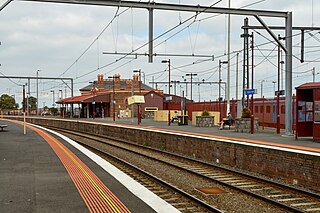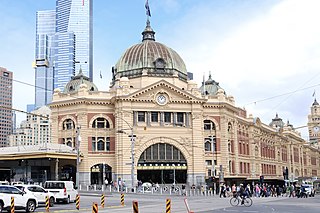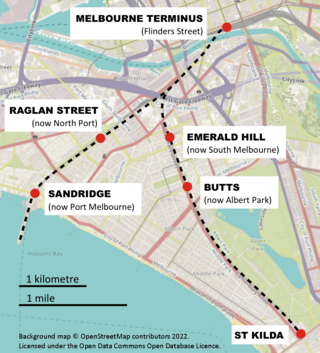Related Research Articles
Cremorne railway station was an inner suburban station in Melbourne, Australia. It was on the Melbourne and Suburban Railway Company’s line from Princes Bridge station to Windsor station, and was located just north of Balmain Street on the Melbourne side of the Yarra River bridge, in a part of the suburb of Richmond which is now known as Cremorne.

Windsor railway station is a commuter railway station on the Sandringham line, which is part of the Melbourne railway network. It serves the south-eastern suburb of Windsor, in Melbourne, Victoria, Australia. Windsor station is a ground level unstaffed station, featuring two side platforms. It opened on 19 December 1859.

Elsternwick railway station is a commuter railway station on the Sandringham line, which is part of the Melbourne railway network. It serves the south-eastern suburb of Elsternwick, in Melbourne, Victoria, Australia. Elsternwick station is a ground level premium station, featuring an island platform. It opened on 19 December 1859, with the current station provided in 1960.

North Brighton railway station is a commuter railway station on the Sandringham line, which is part of the Melbourne railway network. It serves the south-eastern suburb of Brighton, in Melbourne, Victoria, Australia. North Brighton station is a ground level unstaffed station, featuring two side platforms. It opened on 19 December 1859.

Brighton Beach railway station is a commuter railway station, located on the Sandringham line in Victoria, Australia. It serves the south-eastern Melbourne suburb of Brighton, opened on 21 December 1861 as Beach, and renamed Brighton Beach on 1 January 1867. The station building is listed on the Victorian Heritage Register, noted for its unusual shape and proximity to the coastline. The Brighton Bathing Boxes are located a short walk from the station.

St Kilda station is a current tram stop and former railway station, located in the Melbourne suburb of St Kilda, Australia, and was the terminus of the St Kilda railway line in the Melbourne suburban rail system. It is one of the oldest surviving railway station buildings in Victoria. The building is currently used as retail premises, while the platform serves as stop 132 on tram route 96.

The Sandringham line is a commuter railway line in the city of Melbourne, Victoria, Australia. Operated by Metro Trains Melbourne, it is the city's fourth shortest metropolitan railway line at 17.9 kilometres (11.1 mi). The line runs from Flinders Street station in central Melbourne to Sandringham station in the south-east, serving 14 stations via South Yarra, Balaclava, Elsternwick, and Brighton. The line operates from approximately 5am to 12am, daily, with 24 hour service available on Friday and Saturday nights. Services run every 7–8 minutes during peak hour, with services running every 15 minutes during the inter-peak period on weekdays, and every 20 minutes at night and during the day on weekends. Additionally, services run every 60 minutes overnight on Friday and Saturday nights as part of the Night Network. Trains on the Sandringham line run with a two three-car formations of Comeng or Siemens Nexas trainsets.

The Melbourne rail network is a metropolitan suburban and freight rail system serving the city of Melbourne, Victoria, Australia. The metropolitan rail network is centred around the Melbourne central business district (CBD) and consists of 222 railway stations across 16 lines, which served a patronage of 99.5 million over the year 2021–2022. It is the core of the larger Victorian railway network, with regional links to both intrastate and interstate rail systems.

Melbourne tram route 96 is operated by Yarra Trams on the Melbourne tram network from Brunswick East to St Kilda Beach. The 13.9 kilometre route is operated out of Southbank and Preston depots with C2 and E class trams.

The Sandridge Bridge is a historic bridge, which originally carried railway lines over the Yarra River in Melbourne, Victoria, Australia. It runs diagonally to the river and is 178.4 metres (585 ft) long. In 2006, it was redeveloped as a pedestrian and cycle path, featuring public art. It is the third bridge on the site and is listed on the Victorian Heritage Register.
The St Kilda-Windsor railway line was a short-lived section of railway that linked the isolated Windsor to Brighton section of the Melbourne railway network to the city. The branch line fell into disuse when an alternative route was built between Windsor and Richmond stations.

Princes Bridge was a Melbourne railway station built in 1859 and was the terminus for all trains on what are now the Mernda and Hurstbridge lines. The station was named after the adjacent Princes Bridge, which crosses the Yarra River. Originally Princes Bridge station was isolated from Flinders Street station, even though it was adjacent to it, sited just on the opposite side of Swanston Street. Some years later the railway tracks were extended under the street to join the two stations, and Princes Bridge slowly became amalgamated into the larger Flinders Street station. This process was completed in May 1997.

Melbourne tram route 11 is a tram route on the Melbourne tramway network serving the city of Melbourne in Victoria, Australia. Operated by Yarra Trams, the route is coloured turqoise green and extends from West Preston to Victoria Harbour over 13.4-kilometre (8.3 mi) of double track via St Georges Road, Fitzroy and Collins Street. It is serviced out of Preston depot utilising E class trams.

The Melbourne and Hobson's Bay Railway Company was a railway company in Victoria, Australia. The company was incorporated on 20 January 1853 to build the line from Melbourne to the port of Sandridge, now Port Melbourne.
The St Kilda and Brighton Railway Company was a railway company in Victoria, Australia. The company opened a line from St Kilda Railway Station in Melbourne, Australia to Bay Street in 1859 and Beach in 1861.

South Melbourne is a light rail station on the former St Kilda railway line, and was located in the Melbourne suburb of South Melbourne, Victoria, Australia. The station was adjacent to the intersection of Ferrars and Dorcas Streets, just minutes from South Melbourne Market. A pair of low-level side platforms, immediately north of the disused station, now serve route 96 trams on the light rail line, with a pedestrian crossing in between.

Albert Park is a light rail station on the former St Kilda line, located in the Melbourne suburb of Albert Park, Victoria. The station is located on Ferrars Street just to the north of Albert Road, just minutes walk from the Bob Jane Stadium, current home of the South Melbourne Soccer club and the former home of the South Melbourne Football Club. A pair of low level side platforms now serve route 96 trams on the light rail line.

Emerald Hill was an electoral district of the Victorian Legislative Assembly, Australia. It covered part of the inner-city suburb South Melbourne and consisted part of the previous Electoral district of South Melbourne which was abolished in 1859..
The Melbourne tram network began in 1884 with the construction of the Fairfield Horse Tramway. However, the purpose of the line was to increase land prices in the area, and it soon closed during the depression in 1890. The first genuine attempt to construct a tramway network was the construction of the Richmond cable tram line by the Melbourne Tramway & Omnibus Company in 1885. Over the next few years, 16 more cable tram lines were constructed, as well as numerous other horse tramways. The depression of the early 1890s slowed further expansion of the cable network. The first electric tram line was the Box Hill and Doncaster tramway which opened in 1889. This was a pioneering line in what was then the countryside and thus didn't receive much patronage. It closed in 1896. The next attempt at an electric tramway was Victorian Railways' St Kilda to Brighton line, which opened in 1906. Later that year, the North Melbourne Electric Tramway & Lighting Company opened lines to Essendon and Maribyrnong. Many local councils formed their own tramway trusts and built tramways within their own constituency. The most successful of these was the Prahran & Malvern Tramways Trust.
This was a group of 18 2-4-0WT passenger steam locomotives, built by Robert Stephenson & Company and an extra locomotive built from spare parts supplied with the other 18. These locomotives not only provided the bulk workforce of the early private railway operators in Victoria, but upon their withdrawal they once again proved themselves as useful as contractors locos building some of the railway lines for the then expanding Victorian Railway network.
References
- ↑ Map of Melbourne and Suburban Company Lines, 1857–1862, archived from the original on 8 August 2008, retrieved 14 November 2011
- ↑ VICSIG Infrastructure - North Brighton
- ↑ VICSIG Infrastructure - Brighton Beach
- ↑ School of Historical Studies, Department of History. "Railways - Entry - eMelbourne - The Encyclopedia of Melbourne Online". emelbourne.net.au. Retrieved 1 April 2021.
- ↑ "Melbourne & Hobson's Bay United Railway Company". National Library of Australia. Retrieved 1 June 2012.